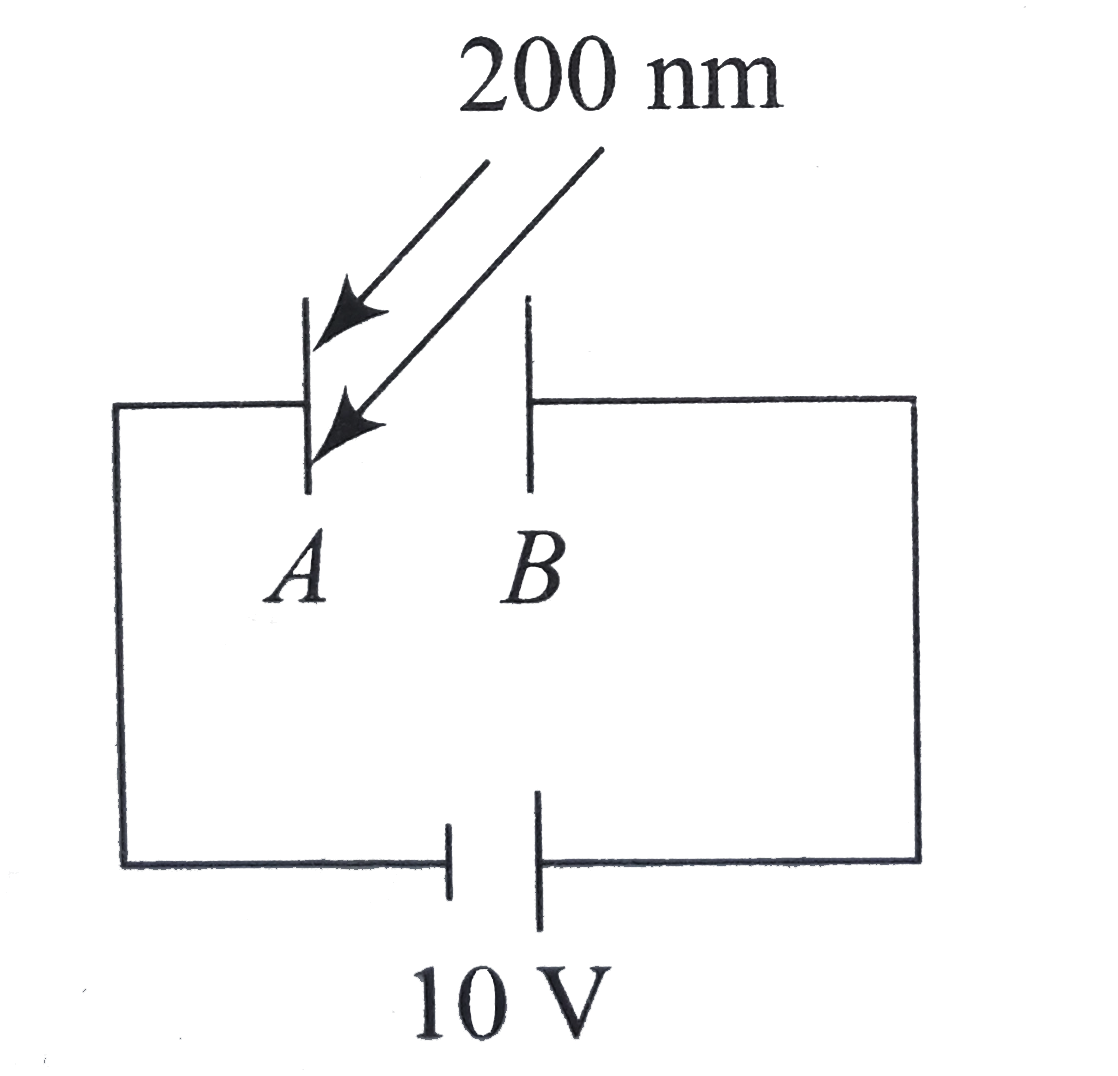A gas containining hydrogen-like ions, with atomic number Z, emits photons in transition n+2→n,wheren=Z These photons fall on a metallic plate and eject electrons having minimum de Broglie wavelength λof5Å. Find the value of Z , if the work function of metal is 4.2eV
The correct Answer is:2
To solve the problem step by step, we will follow the reasoning outlined in the video transcript.
Step 1: Understand the Transition and Energy Calculation
The gas contains hydrogen-like ions with atomic number Z. The transition of interest is from n+2 to n, where n=Z. The energy of the photon emitted during this transition can be calculated using the formula:
E=13.6Z2(1n2−1(n+2)2)
Substituting n=Z:
E=13.6Z2(1Z2−1(Z+2)2)
Step 2: Simplify the Energy Expression
We can simplify the expression:
E=13.6Z2((Z+2)2−Z2Z2(Z+2)2)
Calculating (Z+2)2−Z2:
(Z+2)2−Z2=Z2+4Z+4−Z2=4Z+4
Thus, the energy becomes:
E=13.6Z2⋅4(Z+1)Z2(Z+2)2=54.4(Z+1)(Z+2)2
Step 3: Relate Energy to Work Function and Kinetic Energy
The emitted photons hit a metallic plate, ejecting electrons. The energy of the photons must equal the work function plus the kinetic energy of the ejected electrons:
E=Work Function+K.E.
Given that the work function is 4.2eV and the minimum de Broglie wavelength λ=5Å=5×10−10m, we can calculate the kinetic energy using the de Broglie wavelength formula:
K.E.=h22mλ2
Where h (Planck's constant) is approximately 6.626×10−34Js and m (mass of an electron) is approximately 9.11×10−31kg.
Step 4: Calculate Kinetic Energy
Substituting the values:
K.E.=(6.626×10−34)22×9.11×10−31×(5×10−10)2
Calculating this gives:
K.E.≈6eV
Step 5: Set Up the Equation
Now we can set up the equation:
E=4.2+6=10.2eV
Thus, we equate:
54.4(Z+1)(Z+2)2=10.2
Step 6: Solve for Z
Cross-multiplying gives:
54.4(Z+1)=10.2(Z+2)2
Expanding and rearranging leads to:
10.2(Z2+4Z+4)−54.4Z−54.4=0
This simplifies to a quadratic equation:
10.2Z2−4Z−4=0
Step 7: Use the Quadratic Formula
Using the quadratic formula Z=−b±√b2−4ac2a:
Where a=10.2,b=−4,c=−4:
Calculating the discriminant:
D=(−4)2−4⋅10.2⋅(−4)=16+163.2=179.2
Now substituting into the formula:
Z=4±√179.22⋅10.2
Calculating gives us two possible values for Z, but only the positive integer solution is valid.
Final Answer
After solving, we find:
Z=2
The gas contains hydrogen-like ions with atomic number Z. The transition of interest is from n+2 to n, where n=Z. The energy of the photon emitted during this transition can be calculated using the formula:
We can simplify the expression:
The emitted photons hit a metallic plate, ejecting electrons. The energy of the photons must equal the work function plus the kinetic energy of the ejected electrons:
Substituting the values:
Now we can set up the equation:
Cross-multiplying gives:
Using the quadratic formula Z=−b±√b2−4ac2a:
After solving, we find:
Topper's Solved these Questions
- BOOK - CENGAGE PHYSICS ENGLISHCHAPTER - ATOMIC PHYSICSEXERCISE - Single Correct187videos
ATOMIC PHYSICS
- BOOK - CENGAGE PHYSICS ENGLISHCHAPTER - ATOMIC PHYSICSEXERCISE - Multiple Correct13videos
ATOMIC PHYSICS
- BOOK - CENGAGE PHYSICS ENGLISHCHAPTER - ATOMIC PHYSICSEXERCISE - Exercise 4.212videos
ATOMIC PHYSICS
- BOOK - CENGAGE PHYSICS ENGLISHCHAPTER - ALTERNATING CURRENTEXERCISE - Single Correct10videos
ALTERNATING CURRENT
- BOOK - CENGAGE PHYSICS ENGLISHCHAPTER - CAPACITOR AND CAPACITANCEEXERCISE - Integer5videos
CAPACITOR AND CAPACITANCE
Similar Questions
An electron in Li2+ ion makes a transition from higher state n2 to lower state n1=6. The emitted photons is used to ionize an electron in H-atom from 2nd excited state. The electron on leaving the H-atom has a de Broglie wavelength λ−12.016Å.Find the value of n2.
Note : Use (12.016)2=150×14413.6×11,λÅ=√150KEeVView Solution
In Fig. electromagnetic radiations of wavelength 200nm are incident on a metallic plate A. the photoelectrons are accelerated by a potential difference of 10 V. These electrons strike another metal plate B from which electromagnetic radiations are emitted. The minimum wavelength of emitted photons is 100nm. If the work function of metal A is found to be (×x10−1)ev, then find the value of x. (Given hc=1240eV nm)View SolutionAn electron in hydrogen-like atom makes a transition from nth orbit or emits radiation corresponding to Lyman series. If de Broglie wavelength of electron in nth orbit is equal to the wavelength of rediation emitted , find the value of n . The atomic number of atomis 11.
View SolutionIf the wavelength of the nth line of Lyman series is equal to the de-broglie wavelength of electron in initial orbit of a hydrogen like element (Z=11). Find the value of n.
View SolutionAssertion: In a hydrogen atom energy of emitted photon corresponding to transition from n=2 to n=1 is such greater as compared to transition from n=∞ to n=2.
Reason: Wavelength of photon is directly proportional to the energy of emitted photon.View SolutionIf Photon having wavelength 6.2nmwas allowed to strike a metal plate having work function 50eV then calculate wavelength associated with emitted electron :
View Solutionwhat are the frequency and wavelength of a photon emitted during a transition from n = 5 state to the n =2 state in the hydrogen atom?
View Solutionwhat are the frequency and wavelength of a photon emitted during a transition from n = 5 state to the n =2 state in the hydrogen atom?
View SolutionIn a sample of excited hydrogen atoms electrons make transition from n=2 to n=1. Emitted quanta strikes on a metal of work function 4.2eV. Calculate the wavelength(in A) associated with ejected electrons having maximum kinetic energy.
View SolutionRadiation corresponding to the transition n=4 to n=2 in hydrogen atoms falls on a certain metal (work function=2.5 eV). The maximum kinetic energy of the photo-electrons will be:
View Solution

